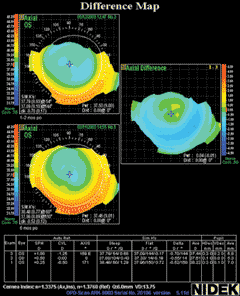CustomCornea re-treatment after previous wavefront-guided re-treatment
A 44-year-old man presents with generally poor visual quality in his left eye after a 1999 LASIK procedure and a 2002 wavefront-guided lift-flap re-treatment.
History
A 44-year-old man presented to our office with complaints of generally poor visual quality and significant glare and halos greater in the left eye than the right eye. These symptoms had been present since myopic LASIK was performed in both eyes in another city.
Initial treatment
In 1999, preoperative manifest refractions were –5.50 –0.25 3 165 in the right eye and –6.25 sphere in the left eye. Pupil measurements in dim lighting were 7 mm in each eye. The patient underwent conventional LASIK with a target of plano in the right eye and –1.5 D in the left eye for monovision. The laser optical zones were 6 mm in each eye.
Postoperatively, the patient complained of glare, halos and “hazy” vision, which were greater in the left eye. Despite a best corrected visual acuity of 20/15 with –1.25 –0.50 3 165 in the left eye postoperatively, the patient had complaints of poor vision quality in the left eye and was deemed to be intolerant of his monovision. In May 2000, he received a lift-flap conventional LASIK re-treatment with a 6-mm optical zone and goal of plano. Postoperatively, the BCVA in the left eye was 20/25 with minimal correction (–0.25 sphere), but he continued to complain of poor quality of vision in his left eye and significant halos and glare in both eyes.
In November 2002, the patient received a wavefront-guided lift-flap re-treatment by a second surgeon in an effort to improve his symptoms. Three months postoperatively, the patient subjectively noted only an approximate 5% improvement in the quality of his vision. Because of his result, he did not elect to proceed with a wavefront re-treatment of the right eye.
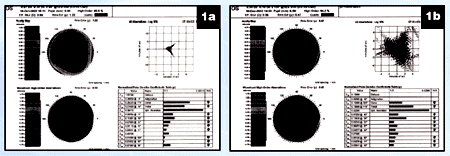 | |
| Preoperative (a) and postoperative (b) wavefront analyses from the left eye of a patient receiving wavefront-guided re-treatment to correct poor visual quality and significant glare and halos. All images courtesy of James Andrew Hiatt, MD. | |
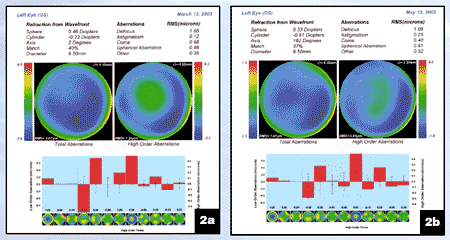 | |
| Wavefront maps taken before (a) and after (b) re-treatment of the same eye as in Figure 1 with wavefront-guided CustomCornea. | |
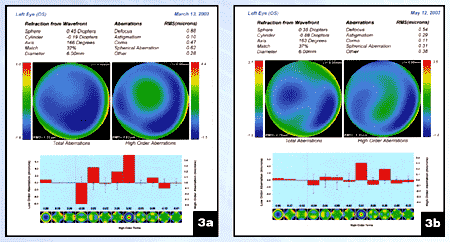 | |
| LADARWave wavefront analyses of the same eye as in Figure 2 (preoperative on left and postoperative on right) but with the analysis diameter changed from 6.5 mm to 6 mm. Notice the significant decrease in the quantity of higher-order aberrations measured. |
CustomCornea re-treatment
The patient presented to our facility in February 2003 with complaints of generally poor visual quality and significant glare and halos in both eyes. The patient elected to undergo wavefront-guided lift-flap re-treatment in the left eye with the Alcon CustomCornea system, which employs the LADARWave wavefront analyzer and the LADARVision4000 excimer laser.
In March 2003, the procedure was performed in the left eye. On postoperative day 1, the patient noticed enough difference in his quality of vision and improvement of his halo and glare phenomena that he decided to have wavefront re-treatment with the CustomCornea system in the right eye. The procedure was scheduled for 1 month later.
|
|
—————————————————————
Preoperative examination left eye:
UCVA: 20/40
Manifest refraction: +0.75 —0.753 175
BCVA: 20/30
Procedure: CustomCornea LASIK lift-flap re-treatment
5-month postoperative examination left eye:
UCVA: 20/25
Manifest refraction: +0.50 —0.25 3 140
BCVA: 20/25
—————————————————————
Comparison of re-treatments
Figure 1 shows preoperative (1a) and postoperative (1b) wavefront analyses from the first wavefront-guided re-treatment of the patient’s left eye. (Some details may be difficult to read on these maps, so key data are also shown in Table 1.) Figure 2 demonstrates before (2a) and after (2b) re-treatment with CustomCornea.
Spherical aberration decreased 18% with the patient’s first wavefront re-treatment and 40% with the CustomCornea treatment. Coma decreased 60% with the first wavefront re-treatment and 52% with CustomCornea re-treatment. Higher-order RMS decreased 18% with the first wavefront re-treatment and 28% with the CustomCornea procedure.
Figure 3 displays the same LADARWave wavefront analyses as Figure 2 (preoperative 3a and postoperative 3b) but with the analysis diameter changed from 6.5 mm to 6 mm. Notice the significant decrease in the quantity of higher-order aberrations measured when the analysis is taken at 6 mm compared to the measurements taken at 6.5 mm. Smaller analysis diameters mask much of the higher-order aberrations.
Table 2 shows how wavefront data taken with the LADARWave system at a standard analysis diameter of 6.5 mm (as they were in Table 1) differ from an analysis of the same eye taken at a diameter of 6 mm. The third column in Table 2 lists percent differences in each parameter. As is shown in Figure 3, smaller analysis diameters mask a significant percentage of higher-order aberrations. In patients with large pupils, however, the pupil does not mask such aberrations, and the patient can have adverse subjective sequelae.
Figure 4 shows standard Marco 3-D topography pre- (lower left) and post-CustomCornea (upper left), as well as a difference map for this patient (right). Pupil diameter is visible as a fine white line in each map. Optical zones can be deduced from central areas of flattening to peripheral steep areas. In the bottom, pre-CustomCornea topography, it is apparent that the pupil diameter is larger than the optical zone created by the original, non-CustomCornea re-treatment. The upper, postoperative topography reveals an optical zone created by CustomCornea that more closely approximates pupil diameter. The effects of the expanded optical zone are evident from the axial difference map (right).
Discussion
Higher-order aberrations may result from conventional LASIK. Coma is common in patients who have decentered excimer laser ablations. Spherical aberration commonly results from small optical zones, and it increases in patients with large pupil diameters combined with higher degrees of attempted myopic correction. Patients whose pupils dilate beyond the functional optical zone can have significant symptoms from spherical aberration. Light entering the pupil from areas of the cornea with different curvature can create multifocality. Spherical aberrations can be perceived as glare, halos, image doubling and/or hazy image quality.
In this patient, coma seemingly decreased more with the first wavefront-guided enhancement procedure than that performed with the Alcon system. Taking the measurements at a 6-mm analysis diameter, however, shows that coma decreased more with CustomCornea (from 0.47 µm to 0.11 µm RMS, or 77%) vs. the other system (from 0.262 µm to 0.104 µm RMS, or 60%). Spherical aberration decreased more after CustomCornea treatment even with the difference in analysis diameter. It is also important to point out that the corrections with CustomCornea were of residual aberrations after the first system’s wavefront-guided correction.
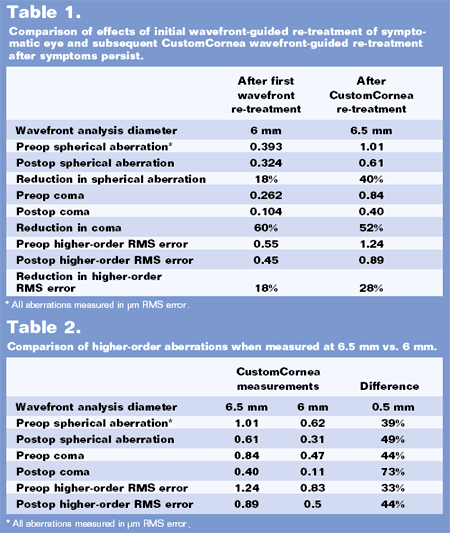
In Table 2, a comparison of LADARWave wavefront analyses at 6.5-mm and 6-mm diameters demonstrates that more higher-order aberrations are measured and can be potentially corrected with larger analysis diameters. Therefore, in treating aberrations in patients with even slightly larger pupils (0.5 mm), a larger analysis diameter can be important. Figure 4 illustrates this concept with pre- and postoperative topographies. The difference map in Figure 4 reveals the CustomCornea ablation pattern used to correct higher-order aberrations, especially spherical aberration. Note the peripheral flattening on the difference map.
The first LASIK system used on this patient employs a 6-mm optical zone and a blend zone to 8 mm. CustomCornea has a 6.5-mm optical zone and a blend to 9 mm. It is reasonable to expect more correction of spherical aberration with a wider wavefront analysis diameter and larger wavefront-guided primary optical zone and blend zone. In the end, it was the improvement in spherical aberration and optical zone expansion that seemed to have made the difference for the patient subjectively, and this was the reason he proceeded with wavefront LASIK re-treatment in the fellow eye.
For Your Information:Brian S. Boxer Wachler, MD, and James Andrew Hiatt, MD, can be reached at Boxer Wachler Vision Institute, 465 N. Roxbury Drive, Suite 902, Beverly Hills, CA 90210; 888-982-1900; fax: 310-860-1902; e-mail: bbw@boxerwachler.com; hiatt@boxerwachler.com. Dr. Boxer Wachler is a paid consultant for Alcon. Dr. Hiatt has no direct financial interest in the products mentioned in this article, nor is he a paid consultant for any companies mentioned.

